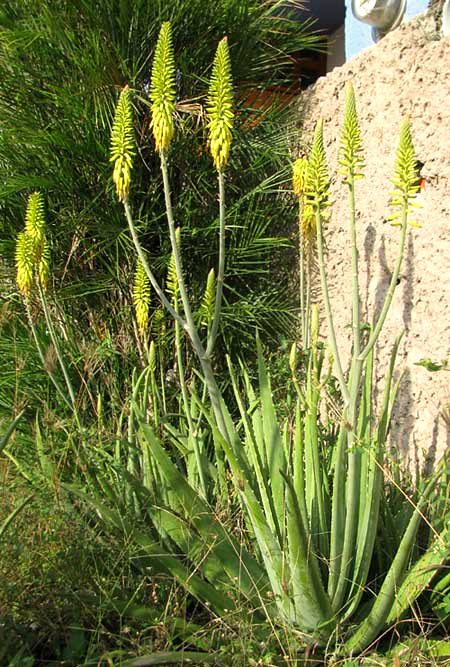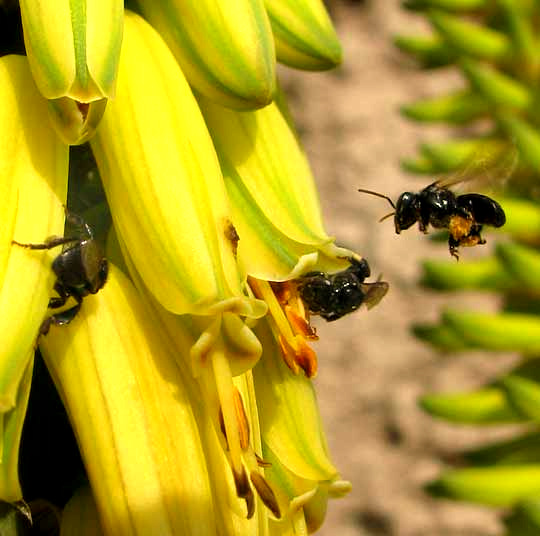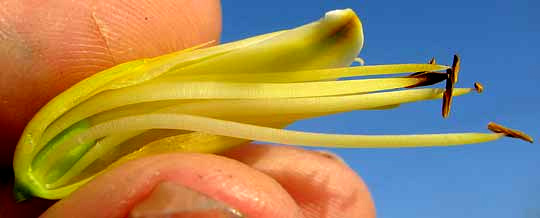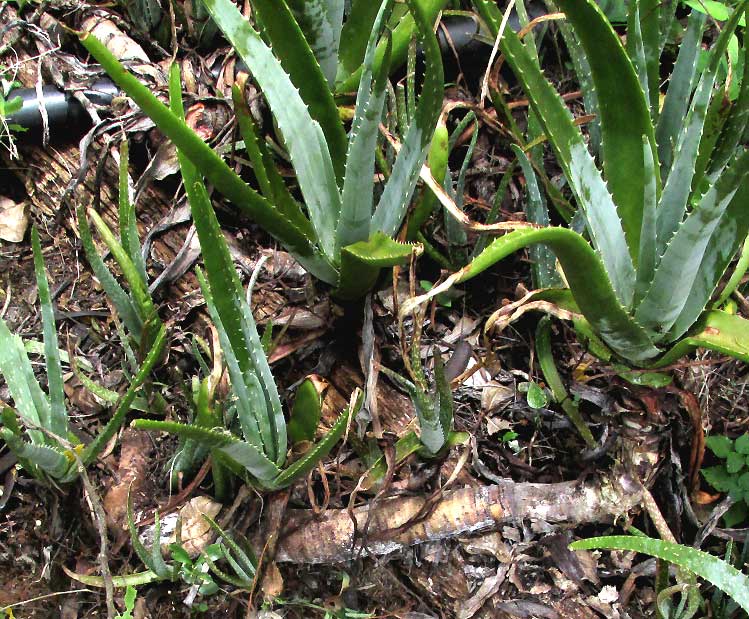Excerpts from Jim Conrad's
Naturalist Newsletter
from the March 7, 2010 Newsletter issued from Hacienda Chichen Resort beside Chichén Itzá Ruins, central Yucatán, MÉXICO; limestone bedrock, elevation ~39m (~128ft), ~N20.676°, ~W88.569°
ALOE VERA FLOWERING
Probably most of you have at one time or another kept a pot of Aloe Vera in your home (Aloe Vera is both the common and scientific name). However, I'll bet that few of your plants ever flowered. Here in the land of no frost they're prettily flowering now, as you can below:

The above plant, growing up against a hot, south-facing hotel wall in Pisté, has succulent blades about knee high and flower clusters some four feet high. You can see some bees busily visiting the drooping flowers below:

A longitudinal section of a flower showing six stamens of slightly differing lengths and an oval, small ovary, the future fruit, nestled at the base of the stamens at the picture's bottom left, is shown below:

At the far right in that picture you might notice how the stamens' brown, baglike, pollen-producing anthers are attached to their yellowish, matchstick-like filaments at their backs so that the anthers can seesaw back and forth and swivel. Such back-attached anthers are said to be "versatile." When identifying flowering plants often it's important to notice how anthers are attached because the manner of attachment is fairly consistent within groups of plants. Many anthers are attached to the filament at their bottoms, and thus are "basifixed."
Anyway, this is the Aloe Vera of commerce, famous as a skin moisturizer, a shampoo base, an ingredient for laxatives and as a digestive aid, and many other purposes. Most of the world’s supply is grown in southern Texas and adjacent northwestern Mexico and the West Indies. Supposedly it's native to islands in the Atlantic. It's often cultivated outdoors in the southwestern United States, where it occasionally escapes. I like to keep a plant in case I get burned. Smear some Aloe Vera juice over a burn and it doesn't form blisters as readily as otherwise.
The Flora of North America assigns Aloe Vera to its own family, the Aloaceae, but other sources place it elsewhere. In school I learned it was in the Lily Family, but at Wikipedia it's put into the Asphodelaceae, which I've never heard of.
Entry issued on June 14, 2019, from the forest just west of Tepakán; elev. ~9m (~30 ft), N21.053°, W89.052°; north-central Yucatán state, MÉXICO
ALOE VERA WITH STEMS
Earlier occupants of the rock hut I live in must have known of Aloe Vera's usefulness, for right beside the outside kitchen there's a population of it, and it's been there a long time. I know it's an old population because of what's seen below:

The plant on the image's right bears a stem that snakes across the picture's bottom and bends away from us. I measure it at 70cm long (28inches). I've never seen an Aloe Vera with such a stem. On the Internet, many descriptions of the plant say that it's stemless. The authoritative online Flora of North America admits that its stems can reach 50cm (20inches), and some authorities with more tropical experience say it can reach 1m (3.3ft) but, still, most of us used to seeing potted Aloe Vera with brittle, succulent, pale green blades arising directly from the soil, probably will find what's shown in the picture illuminating.